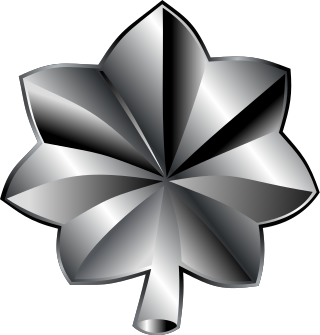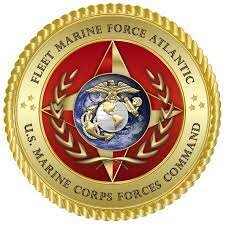A general officer is an officer of high rank in the armies, and in some nations' air and space forces, marines or naval infantry.

James Terry Conway is a retired United States Marine Corps four-star general who served as the 34th Commandant of the Marine Corps. Among his previous postings were Director of Operations (J-3) on the Joint Chiefs of Staff, Commanding General of 1st Marine Division and I Marine Expeditionary Force, taking part in the 2003 invasion of Iraq and the First Battle of Fallujah.

Paul Xavier Kelley was a United States Marine Corps four-star general who served as the 28th Commandant of the United States Marine Corps from July 1, 1983, to June 30, 1987.
The following table shows comparative officer ranks of several Allied and Central powers during World War I.

George Frank Elliott was a United States Marine Corps major general. He was the tenth Commandant of the Marine Corps between 1903 and 1910.

John Archer Lejeune was a United States Marine Corps lieutenant general and the 13th Commandant of the Marine Corps. Lejeune served for nearly 40 years in the military, and commanded the U.S. Army's 2nd Division during World War I. After his retirement from the Marine Corps he became superintendent of the Virginia Military Institute.

George Barnett was the 12th Commandant of the United States Marine Corps. He was a pioneer of amphibious warfare and the U.S. Marine Commandant during American involvement in World War I.

Mitchell Paige was an American retired United States Marine Corps colonel who received the nation's highest military decoration for valor in combat, the Medal of Honor, during World War II.

Earl Edward Anderson was a U.S. Marine four-star general. He was the youngest active duty Marine ever promoted to the rank of general and the first active duty Marine Naval Aviator to be promoted to a 4-star rank. He became Assistant Commandant of the Marine Corps on April 1, 1972. He was promoted to general on March 31, 1972. General Keith B. McCutcheon had been promoted to four-star rank the day of his retirement for medical reasons on July 1, 1971. During his 35-year Marine career, he served in combat actions in World War II, the Korean War, and the Vietnam War.

In the United States Army, Marine Corps, Air Force and Space Force, lieutenant colonel is a field-grade officer rank, just above the rank of major and just below the rank of colonel. It is equivalent to the naval rank of commander in the other uniformed services.
In the United States Armed Forces, a lieutenant general is a three-star general officer in the United States Army, Marine Corps, Air Force, and Space Force.

The history of the United States Marine Corps (USMC) begins with the founding of the Continental Marines on 10 November 1775 to conduct ship-to-ship fighting, provide shipboard security and discipline enforcement, and assist in landing forces. Its mission evolved with changing military doctrine and foreign policy of the United States. Owing to the availability of Marine forces at sea, the United States Marine Corps has served in nearly every conflict in United States history. It attained prominence when its theories and practice of amphibious warfare proved prescient, and ultimately formed a cornerstone of U.S. strategy in the Pacific Theater of World War II. By the early 20th century, the Marine Corps would become one of the dominant theorists and practitioners of amphibious warfare. Its ability to rapidly respond on short notice to expeditionary crises has made and continues to make it an important tool for U.S. foreign policy.

The United StatesFleet Marine Forces (FMF) are combined general and special forces within the United States Department of the Navy that perform offensive amphibious or expeditionary warfare and defensive maritime employment. The Fleet Marine Forces provide the National Command Authority (NCA) with a responsive force that can conduct operations in any spectrum of conflict around the globe.

John Kerry Davis, also known as J.K. Davis, was a United States Marine Corps four-star general. Davis, a Vietnam War veteran and naval aviator, served as the Commanding General of the 3rd Marine Aircraft Wing (1977–1978) and the 1st Marine Aircraft Wing (1978-1978). His final assignment was as the Assistant Commandant of the Marine Corps from July 1, 1983, to June 1, 1986.
The Croix de guerre 1914–1918 was a French military decoration, the first version of the Croix de Guerre. It was created to recognize French and allied soldiers who were cited for valorous service during World War I, similar to the British mentioned in dispatches but with multiple degrees equivalent to other nations' decorations for courage.
The Fleet Marine Force, Pacific (FMFPAC) is the largest maritime landing force in the world. Its units are spread across the Pacific Ocean and reports to the United States Pacific Command. It is headquartered at MCB Camp H. M. Smith, HI and directs and commands all the subordinate elements of the Navy Expeditionary Strike Force and Marine Air-Ground Task Force components that follow under the 3rd, 5th, and 7th Fleet and the Marine Corps Forces, Pacific (MARFORPAC). The Commanding General of Marine Corps Forces, Pacific is dual-posted as the Commanding General of Fleet Marine Force, Pacific. FMFPAC is under operational control of the Commander, United States Pacific Fleet (COMPACFLT), when deployed.

The Fleet Marine Force, Atlantic (FMFLANT) is an American maritime landing force that is spread across the Atlantic Ocean. It is headquartered at Naval Station Norfolk and directs and commands all the subordinate elements of the Navy Expeditionary Strike Force and Marine Air-Ground Task Force components that follow under the 2nd, 4th, and 6th Fleet and the Marine Forces Command (MarForCom). The Commanding General of Marine Forces Command is dual-posted as the Commanding General of the Fleet Marine Force, Atlantic. FMFLANT is under operational control of the Commander-in-Chief, United States Fleet Forces Command, when deployed.
The Military Secretary to the Commandant of the Marine Corps is the senior advisor and task manager for the Commandant of the Marine Corps. Personally selected by the Commandant, the Military Secretary is an active duty colonel who reports directly to the Commandant. The exact duties of the Military Secretary have varied based on the needs and preferences of each Commandant. There are no existing manuals or orders that dictate the exact role of the Military Secretary. They run the day-to-day operations of the Office of the Commandant, supervises the schedule of the Commandant, and performs other duties as the Commandant may direct. In order to perform the multi-faceted duties of the Military Secretary, the Marine must be well versed in all aspects of the United States Marine Corps, the United States Department of Defense, and the United States Government.












